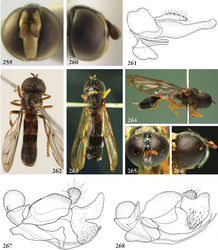Paragodon
| Notice: | This page is derived from the original publication listed below, whose author(s) should always be credited. Further contributors may edit and improve the content of this page and, consequently, need to be credited as well (see page history). Any assessment of factual correctness requires a careful review of the original article as well as of subsequent contributions.
If you are uncertain whether your planned contribution is correct or not, we suggest that you use the associated discussion page instead of editing the page directly. This page should be cited as follows (rationale):
Citation formats to copy and paste
BibTeX: @article{Reemer2013ZooKeys288, RIS/ Endnote: TY - JOUR Wikipedia/ Citizendium: <ref name="Reemer2013ZooKeys288">{{Citation See also the citation download page at the journal. |
Ordo: Diptera
Familia: Syrphidae
Name
Paragodon Thompson – Wikispecies link – Pensoft Profile
- Paragodon Thompson, 1969: 74. Type species: Paragodon paragoides Thompson, 1969: 81, by original designation.
Description
Body length: 4–5 mm. Small flies with short antennae and oval abdomen. Head slightly wider than thorax. Face convex; narrower than an eye. Lateral oral margins not produced. Vertex flat. Occiput ventrally narrow, dorsally widened. Eye bare. Eye margins in male not converging at level of frons, with mutual distance about three times as large as width of antennal fossa. Antennal fossa about as wide as high. Antenna shorter than distance between antennal fossa and anterior oral margin; basoflagellomere longer than scape, oval, about 1.5 times as long as wide, bare. Postpronotum pilose. Scutellum semicircular; without calcars. Anepisternum convex; pilose anteriorly and posterodorsally, widely bare in between. Anepimeron bare or with a few thick, seta-like pile dorsally. Katepimeron convex; bare. Wing: vein R4+5 without posterior appendix; vein M1 straight, perpendicular to vein R4+5; postero-apical corner of cell r4+5 rectangular, with small appendix; crossvein r-m located very close to base of cell dm. Abdomen oval, about 1.5 times as long as wide. Tergites 3 and 4 fused. Sternite 1 bare. Male genitalia: phallus unfurcate, straight, projecting only little beyond apex of hypandrium; hypandrium with bulb-like base; epandrium without ventrolateral ridge; surstylus unfurcate.
Diagnosis
Abdomen oval; yellow and black. Vein R4+5 without posterior appendix. Crossvein r-m almost at same level as base of cell dm. Antenna shorter than distance between antennal fossa and anterior oral margin. Postpronotum pilose.
Discussion
When Thompson (1969)[1] described this genus, he stated that it appeared to be the most primitive microdontine fly known. This was based on a number of presumed plesiomorphic characters: 1) unsclerotized ejaculatory apodeme and sac; 2) short antenna; 3) underdeveloped and bare metasternum; 4) lack of basal setal patches on hind femur; 5) lack of a spurious vein; 6) lack of appendix on vein R4+5; 7) presence of a double sustentacular apodeme; 8) unfurcate phallus. Now that a larger number of taxa of Microdontinae could be studied, all of these characters were also found in other taxa (Reemer and Ståhls in press[2]), except for the unsclerotized ejaculatory apodeme. See also discussion under Surimyia.
Diversity and distribution
Described species: 1. Central America (Mexico, Costa Rica and Panama).
Taxon Treatment
- Reemer, M; Ståhls, G; 2013: Generic revision and species classification of the Microdontinae (Diptera, Syrphidae) ZooKeys, 288: 1-213. doi
Other References
- ↑ Thompson F (1969) A new genus of Microdontine flies (Diptera: Syrphidae) with notes on the placement of the subfamily. Psyche 76: 74-85. doi: 10.1155/1969/62102
- ↑ Reemer M, Ståhls G (in press) Phylogenetic relationships of Microdontinae (Diptera: Syrphidae) based on parsimony analyses of combined molecular and morphological characters. Systematic Entomology 38.
Images
|
